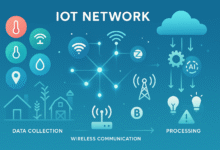How to Secure Your Smart Home Against 2025’s Emerging Threats
This article explores how to secure your smart home against emerging threats in 2025. From understanding vulnerabilities to implementing proactive measures

The rise of smart homes has redefined modern living, offering convenience, energy efficiency, and connectivity. Yet, as more homes integrate internet-connected devices, cybersecurity threats have evolved in both complexity and frequency. With 2025 introducing new vulnerabilities through AI-driven attacks, IoT exploitation, and sophisticated hacking techniques, protecting your smart home is no longer optional—it’s essential.
This article explores how to secure your smart home against emerging threats in 2025. From understanding vulnerabilities to implementing proactive measures, we’ll guide you through a comprehensive security plan tailored to the future of smart technology.
Understanding the Modern Smart Home
A smart home incorporates devices like thermostats, door locks, cameras, lights, appliances, and even voice assistants that are interconnected via the internet. These gadgets improve automation and comfort but also open numerous doors for malicious actors.
In 2025, smart homes typically contain 10 to 50 connected devices, ranging from televisions and refrigerators to HVAC systems and baby monitors. While this connectivity improves daily life, it also expands the attack surface for cybercriminals. A single compromised device could lead to a full network breach.
Why 2025 Is Different: Evolving Threats
The threats of today are more sophisticated than ever. In 2025, we face AI-powered hacking tools, deepfake scams using voice assistants, and botnets composed entirely of IoT devices. Hackers are using machine learning to predict and exploit human behavior patterns, bypassing traditional security measures.
Another concern is device-specific vulnerabilities. Many manufacturers still release smart devices with outdated firmware, weak encryption, or hardcoded passwords. With more obscure and budget-friendly smart gadgets flooding the market, security standards often take a back seat to affordability.
1. Start with a Secure Network
The first line of defense is your home network. Every smart device connects through it, making it a prime target.
-
Change the default SSID and password of your router. Avoid using identifying names and opt for a strong, unique password.
-
Enable WPA3 encryption, which offers stronger protection than the older WPA2.
-
Disable WPS (Wi-Fi Protected Setup) to prevent brute-force attacks.
-
Consider setting up a guest network exclusively for your smart devices. This keeps them isolated from your main devices like laptops and smartphones, reducing the risk of lateral attacks.
A firewall and network segmentation further protect your data, ensuring that even if one device is compromised, the rest of your home remains secure.
2. Always Update Firmware and Software
Manufacturers regularly release firmware updates to patch vulnerabilities. Yet, many users neglect these updates, unknowingly leaving their devices exposed.
-
Enable automatic updates whenever possible.
-
Regularly check manufacturer websites for the latest patches.
-
Avoid using devices from manufacturers that don’t provide long-term support.
Outdated devices become low-hanging fruit for hackers, especially in botnet attacks where thousands of devices are hijacked to launch DDoS or ransomware campaigns.
3. Secure Your Smart Assistants
Voice-controlled devices like Alexa, Siri, and Google Assistant have revolutionized home automation—but they can also be exploited.
-
Disable features you don’t use, like remote access or voice purchasing.
-
Use voice recognition and voiceprint security to limit who can issue commands.
-
Routinely review your device’s activity logs to check for unusual interactions.
-
Ensure the device doesn’t respond to commands from outside your home, especially if you have smart speakers near windows.
2025 has seen the rise of deepfake voice attacks, where hackers replicate a user’s voice to manipulate smart assistants. Enhanced voice authentication is your best defense.
4. Use Multi-Factor Authentication (MFA)
One of the simplest yet most powerful tools in your arsenal is multi-factor authentication (MFA). Most smart home platforms now support this feature.
MFA requires users to provide two or more verification factors to gain access—like a password and a code sent to your phone. This makes it significantly harder for unauthorized users to access your smart home systems, even if they have your login credentials.
For critical systems such as home security cameras, smart locks, and energy controls, MFA should be non-negotiable.
5. Limit Device Permissions
Many smart devices request more access than they actually need. A smart lightbulb, for instance, doesn’t need access to your microphone or contact list.
-
Go through each device’s permission settings in the companion app.
-
Disable unnecessary features or permissions.
-
Be wary of devices that require always-on location tracking or constant internet access.
By minimizing permissions, you reduce the potential data leak pathways and restrict how much damage a compromised device can do.
6. Choose Reputable Brands
Not all smart home devices are created equal. Security standards vary drastically between manufacturers.
-
Prioritize brands with transparent privacy policies, active support forums, and a proven track record of addressing vulnerabilities.
-
Avoid extremely cheap devices from unknown sources, as they often lack basic security measures like encryption or password protection.
-
Look for devices certified with security standards, such as the ETSI EN 303 645 for IoT or certifications from organizations like UL or IoXT.
A reputable brand is more likely to offer security patches, provide data encryption, and respond promptly to reported vulnerabilities.
7. Monitor and Audit Your Smart Home Regularly
A “set it and forget it” approach no longer works in 2025. Regular audits help you stay on top of potential risks.
-
Use network monitoring tools to observe unusual data transfers.
-
Install apps that alert you when new devices join the network.
-
Set up notifications for failed login attempts or device activity during odd hours.
In addition, create a device inventory list. This helps you remember which devices are active, their update status, and any known vulnerabilities.
8. Install a Smart Home Security Hub
A centralized security hub can act as a guardian for your smart home.
These hubs often provide:
-
End-to-end encryption
-
Real-time intrusion detection
-
Unified control over smart devices
-
Firmware and patch management
Look for hubs that integrate with most of your devices, support Zigbee or Z-Wave, and allow for granular permission controls.
By adding a security hub, you not only improve defense but also simplify how you manage your smart ecosystem.
9. Educate Everyone in the Household
The most secure system can still be compromised by human error. User awareness is key to long-term protection.
-
Teach household members to recognize phishing emails and suspicious app requests.
-
Avoid sharing Wi-Fi passwords unnecessarily.
-
Restrict admin-level access to only trusted users.
-
Encourage secure behaviors, like logging out after use or reporting suspicious behavior.
A chain is only as strong as its weakest link—and in most smart homes, that weak link is often a non-tech-savvy user.
10. Plan for Device Lifespan and Retirement
Smart devices don’t last forever. As they age, they may stop receiving updates or support, turning them into security liabilities.
-
Maintain a schedule for evaluating device lifespan every 1-2 years.
-
Decommission and properly reset devices before disposal.
-
Before selling or giving away devices, do a factory reset and wipe all personal data.
As technology evolves, old devices may no longer be compatible with new encryption standards or security protocols, increasing the risk of unauthorized access.
11. Backups and Contingency Plans
Despite your best efforts, breaches can still occur. That’s why data backups and contingency plans are critical.
-
Regularly back up important configurations and files to secure, offline storage.
-
In case of a ransomware attack or breach, you’ll be able to restore your system quickly.
-
Practice resetting your network, updating firmware manually, and revoking device access.
Consider investing in cyber insurance that covers IoT-related damages. Some policies now include protection for smart home attacks, which can offset recovery costs.
Future-Proofing Your Smart Home
Security is not a one-time task—it’s an ongoing commitment. To truly secure your smart home against 2025’s emerging threats, you must remain vigilant, informed, and proactive.
-
Follow tech news for the latest vulnerabilities.
-
Subscribe to firmware release notes and industry bulletins.
-
Join user forums or communities related to your smart devices.
The key to smart home security lies in adopting layered defenses, combining hardware, software, and human behavior. Only then can you create a digital fortress capable of withstanding the evolving threat landscape.
Final Thoughts
Your home is your sanctuary, but in 2025, it’s also part of the global digital battlefield. With attackers growing more sophisticated and the number of connected devices skyrocketing, now is the time to take smart home security seriously.
By implementing these strategies—from securing your network and updating firmware to using MFA and limiting permissions—you’ll dramatically reduce your exposure to cyber threats. Take action today to ensure your smart home remains a safe, efficient, and enjoyable space for years to come.











